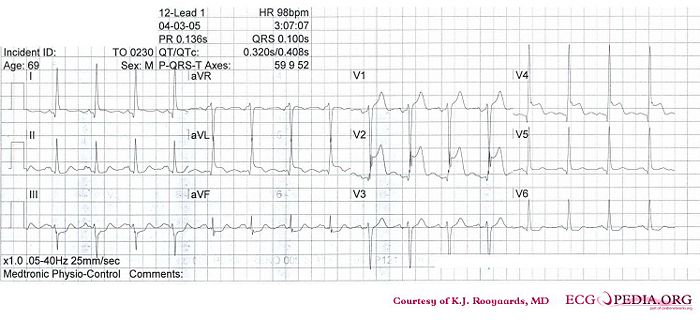Answer MI 20: Difference between revisions
Jump to navigation
Jump to search
New page: thumb| The ECG * Following the 7+2 steps: **Rhythm ***'''The ECG shows a regular rhythm with normal P waves (positive in I, III and AVF, negative in AVR), followed ... |
m Example 10 moved to Answer MI 20 |
||
| (One intermediate revision by the same user not shown) | |||
| Line 1: | Line 1: | ||
[[Image:KJcasus10.jpg|thumb| | {{Case| | ||
|previouspage= MI 19 | |||
|previousname= MI 19 | |||
|nextpage=MI 21 | |||
|nextname=MI 21 | |||
}} | |||
'''Where is this myocardial infarction located?''' | |||
[[Image:KJcasus10.jpg|700px|thumb|left|ECG MI 20. Click on image for enlargement.]] | |||
{{clr}} | |||
==Answer== | |||
* Following the 7+2 steps: | * Following the 7+2 steps: | ||
**Rhythm | **Rhythm | ||
Latest revision as of 11:25, 11 November 2008
| This page is part of Cases and Examples |
Where is this myocardial infarction located?

Answer
- Following the 7+2 steps:
- Rhythm
- The ECG shows a regular rhythm with normal P waves (positive in I, III and AVF, negative in AVR), followed by QRS complexes. Sinusrhythm
- Heart rate
- 100 bpm
- Conduction (PQ,QRS,QT)
- PQ: 140ms QRS: 100ms QT: 320ms QTc: 410ms
- Heartaxis
- QRS positive in I and AVF: normal heart axis
- P wave morphology
- The P waves have normal morphology.
- QRS morphology
- Narrow QRS. No left ventricular hypertrophy. No pathologic Q waves.
- ST morphology
- ST elevation in V1-V4 and lead I. ST depression in II, III, AVF and V6. Lead V3 shows V4R which is not elevated
- Compare with the old ECG (not available, so skip this step)
- Conclusion?
- Rhythm
Sinusrhythm with anteroseptal infarction. Ischemic vector is pointing upwards (ST depression in AVF), a sign of proximal LAD occlusion.